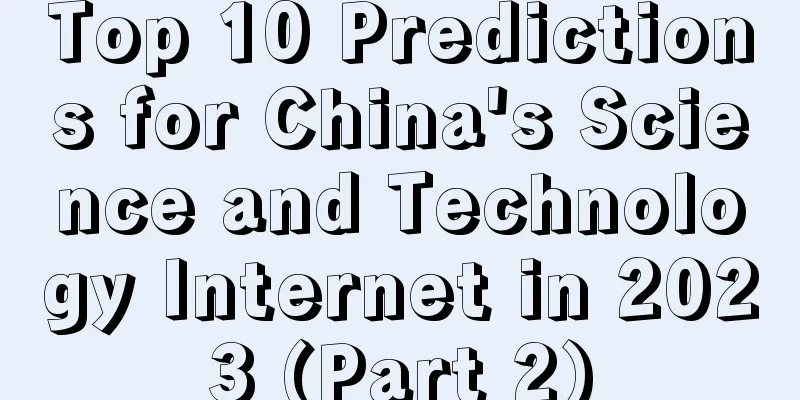Top 10 Predictions for China's Science and Technology Internet in 2023 (Part 2)

"This round of epidemic is coming to an end," the China Centers for Disease Control and Prevention said. "During the Spring Festival holiday, there was no significant rebound in the epidemic, and no new mutant strains were found during the entire epidemic." This is the best news after the holiday. Will the cold weather dissipate along with the epidemic? In 2023, new energy vehicles will explode in the internal circulation. However, there are still uncertainties in XR, and we look forward to the turning point. What is certain is that after the "darkest moment" of the epidemic, industries such as cryptocurrency that started out crazy will calm down. 1. Rabbit Horns and Bull Wings: Cryptocurrency Industry Continues to Be Cold
From the extremely hot market in 2021 to the widespread grief in 2022, cryptocurrency has experienced a crazy roller coaster ride, from great joy to great sorrow, and a group of cryptocurrency followers have begun to doubt cryptocurrency. Against the backdrop of the Federal Reserve's aggressive interest rate hikes, in May 2022, the LUNA coin, known as the "Moutai of the cryptocurrency circle," suddenly collapsed; in July 2022, cryptocurrency hedge fund Three Arrows Capital, crypto lending platform Celsius Network and Voyager Digital filed for bankruptcy one after another. Glassnode data shows that global Bitcoin investors lost a total of $195 billion (about RMB 1,359.7 billion) in 2022. The losses were very heavy, and the myth of "getting rich overnight" in the cryptocurrency circle was shattered. In addition, the amount of illegal transactions and cybercrimes in the field of cryptocurrency continued to rise, reaching a record high of $20.1 billion in 2022. Compared with traditional money laundering crimes, money laundering crimes using encrypted assets are more difficult to detect and track, making governments around the world always highly vigilant about it. Therefore, the crypto industry may face more and stricter supervision in 2023. In contrast, digital currency backed by national credit has developed rapidly in 2022, and the pace will undoubtedly be even faster in 2023. In 2022, there have been major events in the digital RMB field, from promoting the development of legal digital currency standards and announcing the third batch of digital RMB pilot areas, to launching digital RMB smart contract prepaid funds management products, promoting digital RMB into the capital market, and incorporating digital RMB into the statistics of currency in circulation. Digital RMB is a legal tender in digital form issued by the People's Bank of China. Like physical RMB, it is essentially a component of currency. Just a few days ago, the central bank stated that it will orderly promote the research and development of digital RMB and continue to improve the top-level design and ecological system construction. In 2023, against the backdrop of expanding domestic demand, the digital RMB will be more useful. On the one hand, it will support full-scenario applications online and offline by providing convenient exchange, payment, wallet management and other services. On the other hand, it will improve transaction transparency and the level of intelligent fund management, and reduce settlement and compliance costs. At the same time, countries and regions such as the United States, Europe, Russia, and Japan have expressed their intention to steadily introduce digital monetary policies. In November last year, the New York Federal Reserve Innovation Center (NYIC) issued a statement saying that it had started a three-month digital dollar pilot with Wall Street financial institutions including Citigroup, HSBC Holdings, and Mastercard. Also in November last year, relevant personnel from the Bank of Japan stated that they would cooperate with the three major commercial banks, Mitsubishi Tokyo UFJ Bank, Sumitomo Mitsui Banking Corporation, and Mizuho Bank, as well as various local banks to conduct a pilot for the issuance of digital yen. After experiencing the "darkest moment" in 2022, Bitcoin unexpectedly had a "good start" at the beginning of the new year in 2023. The price has been rising in recent times, breaking through the $21,000 mark at one point. However, in the view of many industry insiders, Bitcoin's upside in 2023 is very limited, and it faces the test of the dual risks of losses and regulation. 2. One Eagle and Two Rabbits: New Energy Vehicles Explode in Internal Competition
Safety, battery life, charging, pricing, value retention rate... For new energy vehicles, which are becoming increasingly popular, consumers need to compare too many factors. Coupled with the increasing number of traditional car companies entering the market, as well as cross-industry crossovers, the new energy vehicle industry is full of "gunpowder smell". Once the "gunpowder smell" is strong, there are only two results for the industry: one is that all parties lose, and the other is that the winner is determined. From the perspective of the new energy vehicle market in 2022, the winner has been determined. Some car companies are still fighting for "small goals", while some car companies have already gained rich returns from the market. The most eye-catching one is BYD, the first company in the world to officially announce the suspension of fuel-powered vehicles, which is resolute and courageous. The latest data shows that BYD's sales reached 235,000 vehicles in December 2022, a year-on-year increase of 137.3%. The cumulative sales in 2022 reached 1.863 million vehicles, a year-on-year increase of 208.64%. BYD, the "big brother", performed very well, while Nezha Auto, a dark horse , delivered 152,100 vehicles throughout the year, a year-on-year increase of 118.26%, surpassing Wei, Xiaopeng and Li Auto in terms of data. Among the three companies of Wei, Xiaopeng and Li Auto, Ideal Auto ranked first in terms of delivery in 2022, with annual delivery of 133,200 vehicles, a year-on-year increase of 47%. However, behind the prosperity of the new energy vehicle industry, there are also hidden worries. Insufficient chip supply, factory shutdowns, battery price increases... These uncertainties all pose challenges to the stable development of the industry. Especially for new car manufacturers, the era of "NIO, Xiaoli and Li Auto" dominating the top three in sales is coming to an end. The sales of Nezha and Leapmotor, which focus on cost-effectiveness, are rapidly climbing. At the same time, new energy brands of traditional car companies are coming on strong. Feng Xingya, general manager of GAC, has already made a bold statement: "GAC Aion's goal is to turn 'NIO, Xiaoli and Li Auto' into 'Aion, Xiaowei and Li Auto'". Changes in new energy vehicle support policies, the accelerated transformation of traditional automakers, high manufacturing and operating costs, and the shortage of chips and expensive electricity will widen the sales gap and affect the development momentum of automakers. In short, in the new energy vehicle track, "involution" is still continuing and will become more intense, and new forces have not yet gotten out of the quagmire of "the more they sell, the more they lose." It has to be said that 2023 will still be difficult. Zhang Xiuyang, secretary general of the China Passenger Vehicle Industry Alliance, said that in 2023, more than 100 new energy vehicles will be launched in China, and the market competition will be more intense than before. The pattern and ranking of new forces will also usher in several rounds of impact and change. However, the performance of "big brother" BYD should be even stronger. Wang Chuanfu has set the sales target for 2023 at 4 million vehicles, doubling that of 2022. The new high-end car brand "Yangwang" officially launched on January 5th is going to impact the market above one million. In 2023, new energy vehicle companies will usher in a real era of great competition. Faced with various shocks, new car-making forces are likely to form a new first echelon in 2023, and engage in fierce competition in product upgrades and brand building. In addition to competing for the domestic market, the foreign market will also become a piece of "fat meat" to expand development space. 3. The wolves run away and the rabbits escape: The epidemic is over and people are back to their normal lives
On December 7, 2022, the State Council Joint Prevention and Control Mechanism Comprehensive Group issued the "Measures for Further Optimizing the Implementation of COVID-19 Prevention and Control", announcing that high, medium and low risk areas will no longer be divided, traffic control will be cancelled, all vehicles will pass normally, residents will resume normal traffic, and residents will no longer need to check their travel code, health code or nucleic acid test certificate when traveling. The strict epidemic prevention measures that lasted for three years have been relaxed, and the countdown to the return of daily life has begun. Looking back at 2022, "epidemic" is a keyword listed by many people in their annual summary. Working from home, getting up early to buy food, logistics stagnation... On the one hand, the epidemic has made people more dependent on online lifestyles, driving the development of a number of online platforms such as fresh food e-commerce and community group buying; on the other hand, offline physical isolation has led to a serious shortage of takeaway boys, couriers and other people who connect online and offline, limiting the normal development of online platforms. Quest Mobile data shows that after the outbreak of the epidemic in Shanghai in mid-March 2022, Dingdong's DAU in March soared 66% month-on-month and 66% year-on-year compared with February. On the express logistics side, regional restrictions caused by the epidemic have hindered express delivery, terminal collection and delivery, and the growth of express delivery business has slowed down across the board. Data shows that from January to November 2022, my country's express delivery business volume totaled 10.02 million orders, a year-on-year increase of only 2.21%, a cliff-like decline compared with the growth rate of nearly 30% in the previous two years. The stagnation of logistics has spread to all walks of life, causing the supply chain of all walks of life to break, seriously affecting industry production. Such a scene may soon become an urban legend. Now that the policy has been opened up, after successfully passing the first round of the epidemic peak, the long-lost atmosphere of human life has returned. There are more stores on the food delivery platform, express riders are back on the streets, and the speed of logistics has also increased a lot... At this time, it is only a month away from the policy relaxation. It can be said that "wolves run and rabbits escape" is the most appropriate way to describe the speed at which the impact of the epidemic has dissipated. Although some experts predict that my country may face the second and third rounds of the epidemic in 2023, the "wolf" has gone and the big impact is no longer there, and although the "rabbit" is still not far away, the impact of the epidemic on life will no longer be obvious. With the return of logistics, the situation of suspension and reduction of production in various industries will improve rapidly. At the living level, with the return of many small businesses and the return of the takeaway industry to normal levels, people's online and offline lives are becoming the same as usual. However, for fresh food e-commerce and community group buying, since the consumer groups are still mainly white-collar workers, after life returns to normal, older consumers and low-income people who have developed consumption habits during the epidemic may return to the offline market. The competition between fresh food e-commerce and vegetable markets and street fruit stores will return to the competition of price and quality. If they want to achieve substantial development in the new cycle, fresh food e-commerce may need to further improve the quality of their products and pass on the benefits to consumers. 4. A rabbit does not eat grass near its nest: Promoting the "dual carbon" strategy is an endogenous requirement
"2022 is a critical node for global sustainable development. Despite the ever-changing international situation, the general trend of global green and low-carbon transformation has not changed, and the international process towards carbon neutrality is irreversible." In December 2022, Gao Peiyong, vice president of the Chinese Academy of Social Sciences, said this in public. Overall, in 2022, China's "1+N" policy system for carbon peak and carbon neutrality has been basically established, key tasks in various fields have been carried out in an orderly manner, and the work of carbon peak and carbon neutrality has made a good start. Achieving the "dual carbon" goal is China's solemn declaration to the world. Looking to the future, China's exploration of a Chinese-style high-quality development path that prioritizes ecology, is green and low-carbon has great potential. At present, my country has become the world's largest carbon spot market. As one of the core policy tools for achieving carbon peak and carbon neutrality goals, driven by the "dual carbon" goals, the industry coverage of the national carbon market will gradually expand in the future. Experts predict that the national carbon trading amount will increase significantly in 2023. On this basis, all walks of life have promoted transformation and upgrading, and achieving green and low-carbon development has become a new trend, such as new energy vehicles, green data centers, green buildings, and so on. In the process of promoting transformation, the research and development of new energy core technologies is still the focus of achieving the "dual carbon" goal. As of 2022, my country's renewable energy installed capacity has exceeded 1.1 billion kilowatts, accounting for more than 34% of the world's total. Hydropower, wind power, solar power generation, and biomass power generation are all ranked first in the world, setting many world records; a total of 2,783 national green factories, 223 national green industrial parks, and 296 national green supply chain management demonstration enterprises have been built, covering major industrial sectors, and a green manufacturing system has been initially formed. The policies issued by the Central Economic Work Conference and relevant ministries of the State Council clearly state that efforts should be made to tackle new materials, technologies and equipment for low-carbon, zero-carbon, negative-carbon and energy storage, while focusing on cutting-edge low-carbon technologies such as high-efficiency solar cells, hydrogen production from renewable energy, controlled nuclear fusion, and zero-carbon industrial process reengineering. It can be foreseen that in 2023, China's photovoltaic, wind power and other new energy sources will continue to expand in scale, and virtual power plants, energy storage and other infrastructure supporting the construction of new energy systems will also play a big role. Promoting the "dual carbon" strategy is not only China's international obligation, but also an endogenous requirement for China's development. In 2023, my country will continue to actively and steadily promote carbon peak and carbon neutrality, continue to focus on the transition from "dual control" of energy consumption to "dual control" of carbon emissions, and vigorously develop green and low-carbon industries. Green development is not a substitute option, but the only way to sustainable development. 5. The death of the rabbit makes the fox sad: the XR industry expects a turning point
XR (extended reality) can be divided into three forms: AR (augmented reality), VR (virtual reality) and MR (mixed reality). From the perspective of the technical difficulty of software, hardware and platform implementation, the three are gradually increasing. There are many new XR hardware devices such as AR glasses and VR all-in-ones that will be launched in 2022, and the iteration speed is not slow. For example, VR headsets and all-in-ones have generally used mini OLED screens with higher brightness and smaller chips. Manufacturers entering the AR glasses market have brought different forms of products with their own design ideas. However, in terms of software and content ecology, XR still lacks sufficient appeal, and the Metaverse cannot carry all the hopes. At least for ordinary consumers, working, making friends, education, and entertainment in the Metaverse do not seem to be very attractive at present. Games and movies are still the selling points of AR and VR products on the C-end. In the platform part between software and hardware, Meta, which is "all in the metaverse", is trying to establish its own XR standard and hopes that it will become the industry standard to consolidate its leadership in the XR industry. Apple is also ambitious. It is rumored that with the release of MR headsets, it will create a dedicated headset operating system "XROS" and is also preparing to open an app store for headsets. There is no doubt that the two giants, Meta and Apple, are bound to have a fierce battle in the consumer market. In China, XR is also highly anticipated. The 14th Five-Year Plan and the Outline of the Long-Term Goals for 2035 lists the "virtual reality and augmented reality" industry as one of the seven key industries for the development of the digital economy. In terms of XR hardware design, Chinese manufacturers already have their own unique advantages, but in terms of standards, the industry chain needs to work together. According to data released by market research firm CCS Insight, shipments of XR devices in 2022 will be less than 10 million units, a year-on-year decrease of 13% compared to 2021. The decline is due to declining consumer confidence caused by global economic uncertainty and price increases caused by inflation. However, the situation is very likely to change in 2023. The industry generally believes that the market turning point will occur in the second half of 2023 , and it is expected that the annual shipments in 2023 will grow again to 11.4 million units, roughly the same as in 2021. From 2024, the sales of XR devices will begin to accelerate significantly, growing to 66.8 million units by 2026, of which 16% are expected to be used by enterprises or institutions. XR is still quite far from the "Oasis" in the movie "Ready Player One" or the equipment in Iron Man's home, but if we keep moving forward, we will eventually arrive. Author: Pan Shaoying, Fan Xinru, Lin Fei, Jia Tianrong, Mao Yu; Editor: Qian Lifu, Ai Tiemei Source: IT Times (ID: vittimes) |
<<: Where to find growth in 2023? 丨Douyin VS Kuaishou Advertising
>>: Seven things marketers can learn from "The Rush"
Recommend
How to generate Amazon ASIN code? Is it important?
Whether it is domestic e-commerce or cross-border ...
WeChat new version, several practical functions updated
Recently, WeChat has been updated again. This time...
How many products does Wish list in a day? What are the rules?
There are many cross-border e-commerce platforms n...
TikTok is no longer running wild
Before this, the only apps in the world with more ...
How to advertise on Lazada? How does Lazada operate?
Lazada is also a cross-border e-commerce platform....
1000 original articles completed! Here's a 3000-word summary for you!
The author shares his creative ideas for writing 1...
If you were a cookie shop owner, how would you use Internet thinking to sell cookies?
The current employment situation is not optimistic...
Why is Amazon's shopping cart win rate decreasing? How to maintain the share?
Amazon is now a popular e-commerce platform. Many ...
Is shopping on Amazon China reliable? Are all products genuine?
As people's economic ability improves, many pe...
Can I withdraw my funds if Amazon KYC audit fails? How to file a KYC appeal?
Each e-commerce platform has its own regulations. ...
Talk about the changes in commercial bank retail business and private domain practices
For many industries now, private domain building i...
How to add a carousel to an independent website? Is it easy to build an independent website?
In today's Internet age, an excellent website ...
The transaction volume has shrunk 10 times, and the live broadcaster failed to "job-hop"
How are those anchors who switched from Douyin to ...
How to reduce Amazon return rate? What are the methods?
In online sales, handling returns is an important ...
Earn 800+ from one article. It is so profitable to be a good self-media person!
Can I make money by offering paid reading on a pub...









